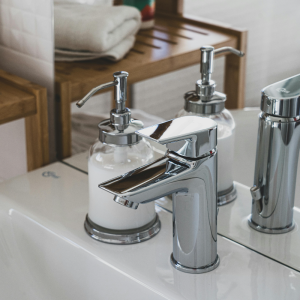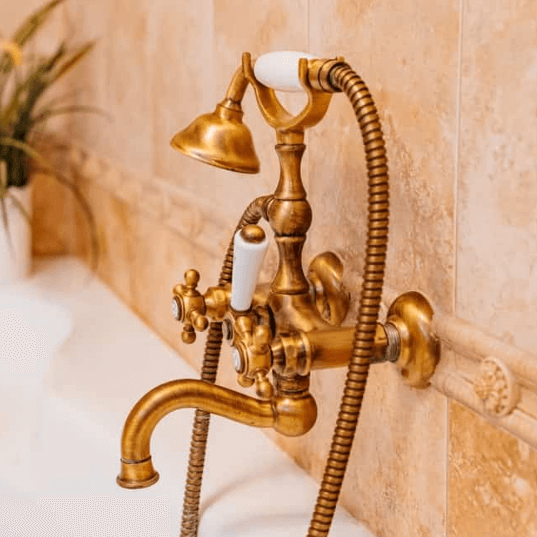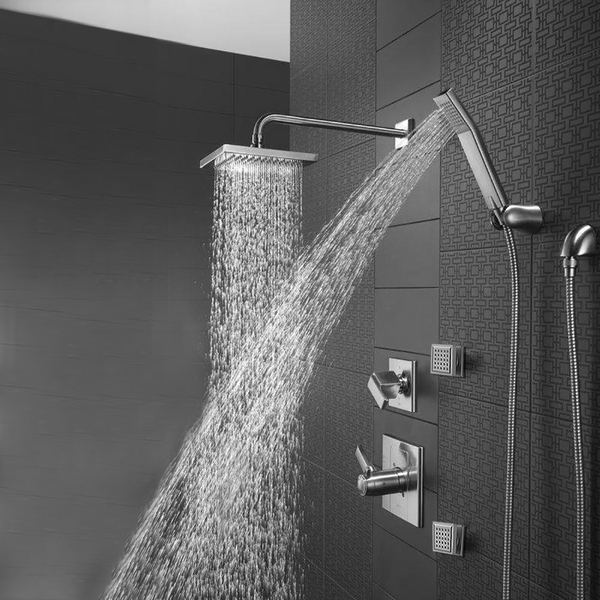Types of Faucet Handle
Faucets play a vital role in our daily lives, whether in kitchens, bathrooms, or commercial spaces. One critical aspect of faucet design that affects both functionality and aesthetics is the type of handle. Lever, cross, and touchless handles each bring unique benefits and features, catering to diverse user needs and preferences. In this article, we explore Types of Faucet Handle with respect to the characteristics, advantages, and applications of these faucet handle types to help you make an informed decision.
Lever Handles
Lever handles are among the most popular and widely used faucet handle types. They are known for their simplicity, ease of use, and modern appeal. A lever handle is typically a straight or slightly curved handle that can be moved up, down, left, or right to control water flow and temperature.

Characteristics of Lever Handles
- Design Versatility: Lever handles come in various designs, from minimalist styles to more decorative and ornate options. This versatility makes them suitable for a wide range of interior styles, including contemporary, transitional, and even some traditional designs.
- Ease of Operation: With a single motion, users can adjust both the water temperature and flow, making lever handles user-friendly for all age groups. Some models also come with ergonomic designs, enhancing comfort during use.
- Material Options: Lever handles are made from a variety of materials, including stainless steel, brass, and plastic. They can also feature finishes such as chrome, matte black, or brushed nickel to match the faucet body and complement other hardware in the space.
- Single or Double Lever: Lever handles can come as single-handle faucets, controlling both hot and cold water, or as double-handle faucets, providing separate controls for each.
Advantages of Lever Handles
- Accessibility: Lever handles are easy to operate, even for individuals with limited hand strength or dexterity, such as the elderly, children, or people with disabilities.
- Hygiene: Single-lever designs minimize contact with surfaces, reducing the spread of germs. Some models even feature antimicrobial coatings.
- Convenience: Adjusting water flow and temperature is quick and intuitive, saving time during tasks like washing hands, filling pots, or cleaning.
Ideal Applications for Lever Handles
Lever handles are ideal for residential and commercial spaces, particularly in modern or transitional settings. They are commonly found in kitchens and bathrooms where practicality and style are essential. For instance, kitchen faucets with high-arc spouts and single lever handles are popular due to their ability to accommodate large pots and pans.
Cross Handles
Cross handles, characterized by their traditional X-shaped design, exude a classic and timeless charm. These handles are often paired with vintage or antique-style faucets, making them a popular choice for traditional and retro-inspired interiors.

Characteristics of Cross Handles
- Symmetrical Design: Cross handles feature a balanced, symmetrical appearance that adds elegance to any faucet. The classic X shape provides a tactile grip, making them easy to turn.
- Separate Controls: Typically, cross handles are designed for dual-handle faucets, where one handle controls hot water and the other controls cold water. This separation allows for precise temperature adjustments.
- Durability: Often crafted from durable materials like brass, stainless steel, or ceramic, cross handles are built to last and maintain their appearance over time. Many models also feature high-quality finishes to resist tarnishing and corrosion.
- Customizable Options: Cross handles can come with decorative elements, such as porcelain inlays or engraved temperature indicators, adding to their charm and functionality.
Advantages of Cross Handles
- Aesthetic Appeal: Their timeless design enhances the overall look of traditional and vintage bathrooms and kitchens. They pair beautifully with features like clawfoot tubs, farmhouse sinks, and subway tile backsplashes.
- Durability: Cross handles are less likely to wear out due to their robust construction. They often use ceramic disc cartridges for smooth operation and long-term reliability.
- Precision: Users have precise control over water temperature and flow by adjusting each handle individually, making them ideal for tasks requiring specific water temperatures.
Ideal Applications for Cross Handles
Cross handles are best suited for classic and vintage-style interiors. They work well in bathrooms with clawfoot tubs, pedestal sinks, and other retro elements. Their elegant appearance also makes them a favorite for high-end or luxury spaces. Additionally, they’re often seen in boutique hotels and heritage properties that aim to retain a nostalgic ambiance.
Touchless Handles
Touchless faucet handles represent the pinnacle of modern innovation and convenience. Equipped with motion sensors or infrared technology, these faucets eliminate the need for physical contact, allowing users to control water flow with a simple wave of the hand.

Characteristics of Touchless Handles
- Sensor Technology: Touchless faucets use sensors to detect movement, automatically turning the water on and off. Advanced models may also include features like adjustable sensor sensitivity and timer settings.
- Energy Efficiency: Many touchless faucets include features like automatic shutoff to conserve water and reduce utility bills. Some models are equipped with LED indicators to signal low battery levels.
- Battery or Power Supply: These faucets are powered by batteries or connected to an electrical source, depending on the model. Some high-end models also offer solar-powered options for enhanced sustainability.
- Customizable Flow Rates: Many touchless faucets allow users to preset flow rates and temperature levels, ensuring consistent and efficient performance.
Advantages of Touchless Handles
- Hygiene: Touchless operation minimizes contact with potentially contaminated surfaces, making them ideal for public restrooms, hospitals, and food preparation areas. This feature significantly reduces the risk of spreading bacteria and viruses.
- Water Conservation: Automatic shutoff prevents water wastage, making these faucets eco-friendly. Some models include water usage monitoring to track conservation efforts.
- Convenience: Hands-free operation is particularly useful when hands are dirty, full, or occupied, such as during food preparation or while handling raw meat.
Ideal Applications for Touchless Handles
Touchless faucets are perfect for public and commercial spaces, including restaurants, schools, and healthcare facilities. They are also gaining popularity in modern residential kitchens and bathrooms, where convenience and cleanliness are prioritized. In high-traffic households, touchless faucets offer a practical solution to maintain hygiene while minimizing water waste.
Comparison of Lever, Cross, and Touchless Handles
| Feature | Lever Handles | Cross Handles | Touchless Handles |
| Ease of Use | High | Moderate | Very High |
| Design Versatility | Wide Range | Traditional Only | Modern Only |
| Hygiene | Moderate | Low | High |
| Water Conservation | Moderate | Low | High |
| Installation Cost | Affordable | Affordable | Higher |
| Maintenance | Low | Low | Moderate to High |
| Durability | High | Very High | Moderate |
Factors to Consider When Choosing a Faucet Handle Type
- User Demographics: Consider the needs of those who will use the faucet. Lever handles are excellent for accessibility, while touchless faucets are perfect for hygiene-conscious environments. Cross handles may require more effort to operate and are better suited for users who appreciate traditional aesthetics.
- Interior Style: Match the handle type with the overall aesthetic of your space. Cross handles suit vintage designs, while lever and touchless handles complement modern styles. Think about other fixtures in the room to ensure a cohesive look.
- Budget: Touchless faucets tend to be more expensive due to their advanced technology, whereas lever and cross handles are more budget-friendly. Factor in not only the initial purchase price but also the long-term maintenance costs.
- Maintenance: Touchless faucets may require battery replacements or sensor cleaning, while lever and cross handles are easier to maintain. For areas with hard water, ensure the materials and finishes are resistant to limescale buildup.
- Functionality: Choose a handle type that aligns with the intended use. For example, touchless handles are ideal for kitchens, where hands-free operation is often needed, while cross handles add character to decorative bathroom settings.
- Sustainability: If water conservation is a priority, touchless faucets with smart features are the best choice. Lever handles also offer reasonable efficiency when operated correctly.
Conclusion
Choosing the right faucet handle type is crucial for both functionality and design. Lever handles provide ease of use and modern appeal, making them a versatile choice. Cross handles offer timeless elegance and precise control, ideal for traditional settings. Touchless handles bring innovation and hygiene to the forefront, perfect for modern and public spaces. By considering factors like user needs, style preferences, budget, and maintenance requirements, you can select the faucet handle type that best fits your requirements and enhances your space. Whether you prioritize aesthetics, convenience, or sustainability, there’s a faucet handle type that’s perfect for you.



